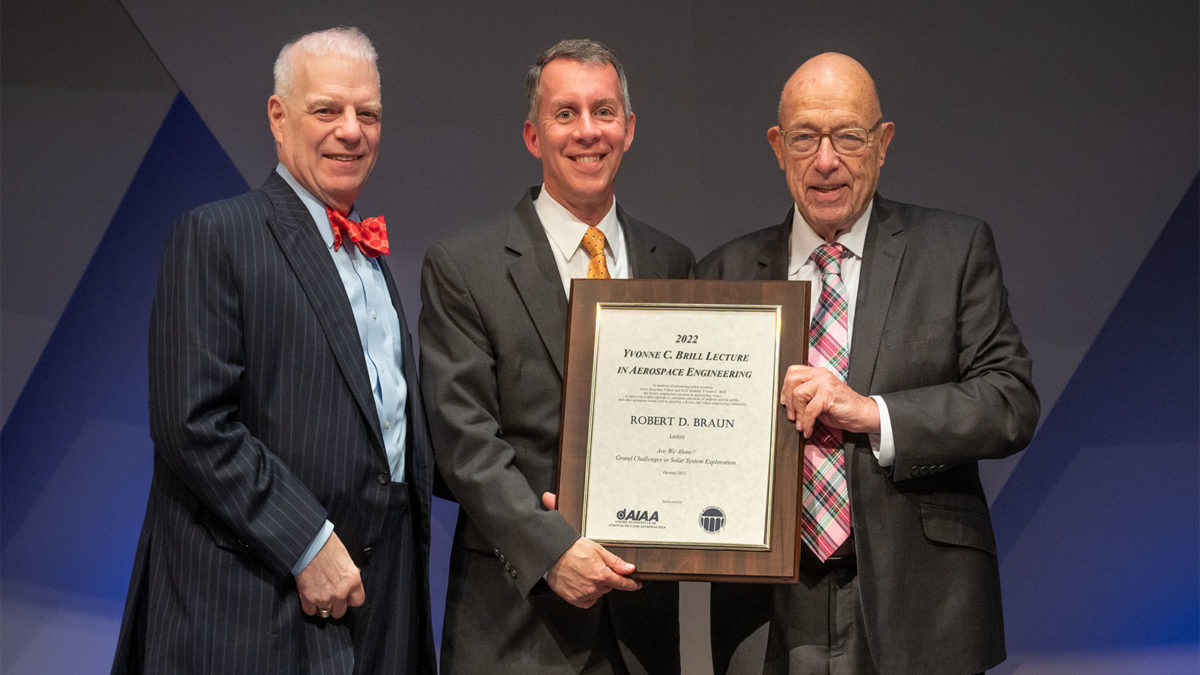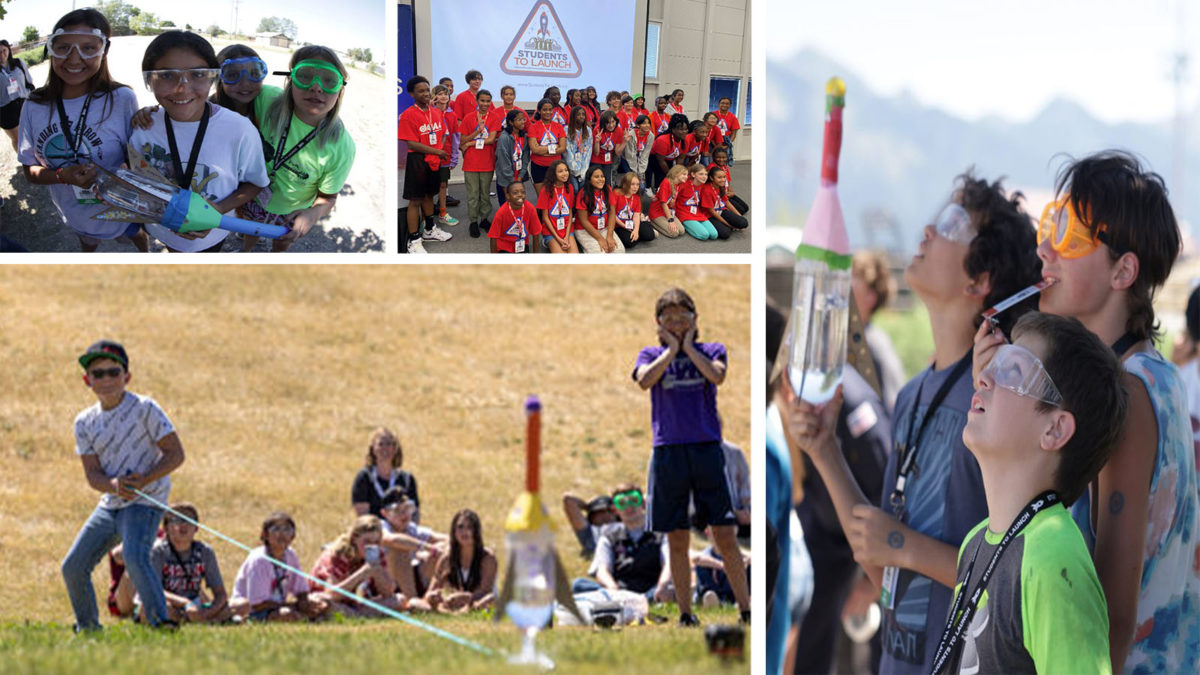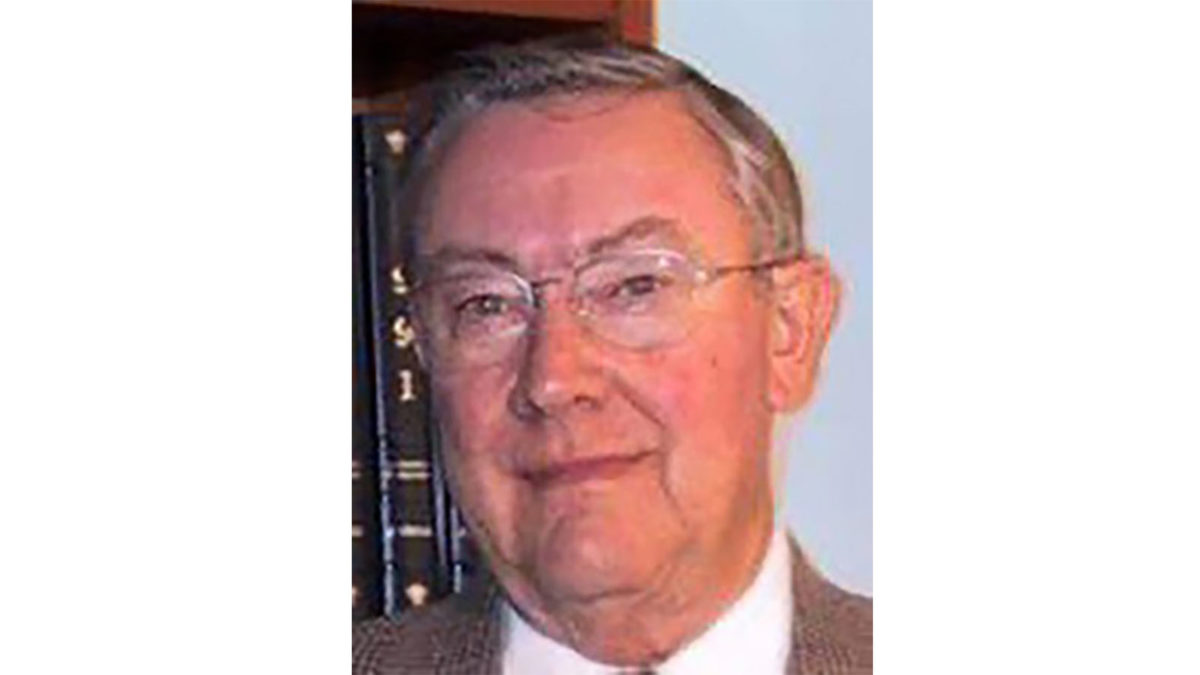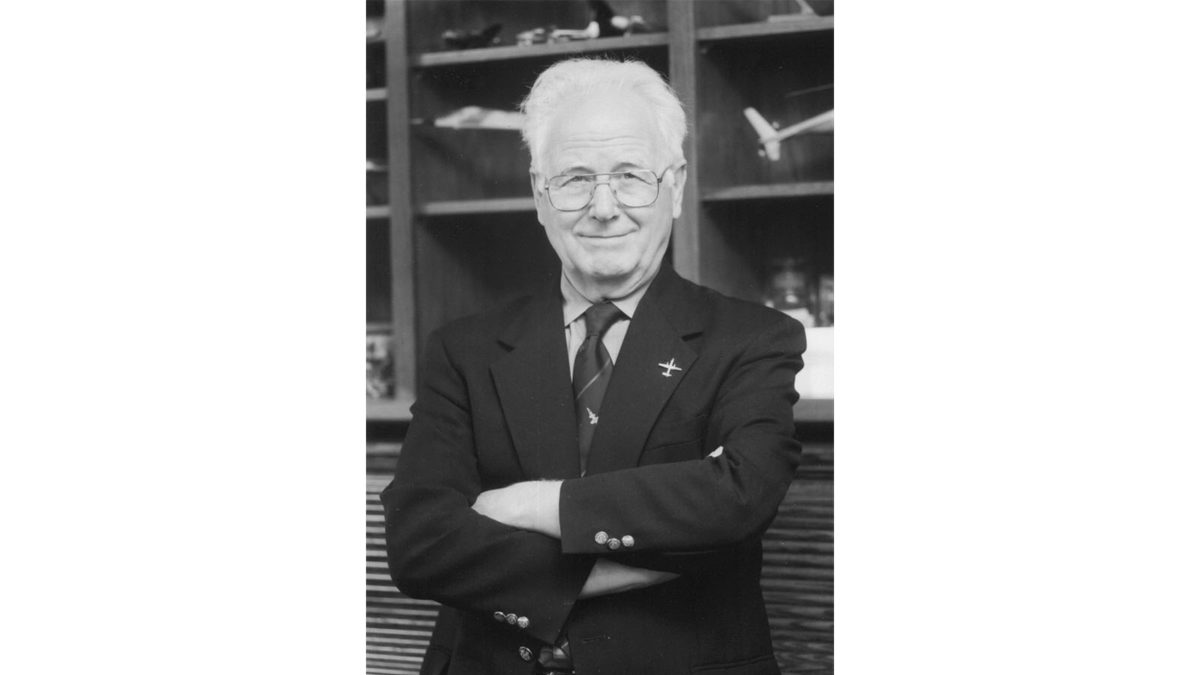- AIAA Announces Candidates for 2023 Election
- Russell M. Cummings Appointed AIAA Education Series Editor-in-Chief
- Braun Gives Brill Lecture in Aerospace Engineering
- Making an Impact: AIAA Launches New STEM Initiative
- November is National Scholarship Month
- AIAA Announces University Student Design Competitions Winners
- AIAA Associate Fellow Martino Died in July
- AIAA Fellow Rand Died in August
- AIAA Fellow Roskam Died in September
- AIAA Associate Fellow Jaggard Died in September
- 2022 Best Professional and Student Papers
Bulletin
AIAA Announcements AIAA Announces Candidates for 2023 Election
The Council Nominating Committee has selected candidates for next year’s openings on the AIAA Council of Directors. Elections will be held January/February 2023. Council Nominating Committee Chair John Blanton and AIAA Governance and Executive Operations Administrator Susan Silva confirmed the names of the candidates who will appear on the 2023 ballot.
Integration and Outreach Activities Division
Director–Business and Management Group
Gustavo Ordonez, Icarus Management Consulting, and University of California
Abdi Khodadoust, The Boeing Company
Director–International Activities Group
Thomas Sebastion, MIT Lincoln Laboratory
Robert Winn, Engineering Systems, Inc.
Director-Elect–Young Professionals Group
Bryan Kowalczyk, University of Cincinnati
Regional Engagement Activities Division
Director–Region I
Timothy Dominick, Northrop Grumman Defense Systems
Kyle Zittle, Johns Hopkins University Applied Physics Laboratory
Director–Region II
Ryan Sherrill, Air Force Research Laboratory
Director–Region VII
Cees Bil, RMIT University
Technical Activities Division
Director–Aircraft Technology, Integration,
and Operations Group
David Maroney, The MITRE Corporation
Director–Space and Missiles Group
Stephen Blanchette, The Aerospace Corporation
Publications News Russell M. Cummings Appointed AIAA Education Series Editor-in-Chief

In January 2023, Russell M. Cummings, Professor of Aeronautics, U.S. Air Force Academy, will assume responsibility as the new editor-in-chief of the AIAA Education Series. Cummings succeeds Joseph Schetz of Virginia Polytechnic Institute and State University, who has served as editor-in-chief of the book series since 2003.
The AIAA Publications Committee oversees the search and selection effort for new editors-in-chief. This year’s search committee was led by Noel Clemens, University of Texas at Austin, Publications Committee member. Cummings was chosen from among a group of highly qualified candidates.
Cummings holds a Ph.D. in Aerospace Engineering from the University of Southern California and Master of Engineering and B.S degrees in Aeronautical Engineering from California Polytechnic State University. He is currently a Professor of Aeronautics and managing director of the DoD HPCMP Hypersonic Vehicle Simulation Institute at the U.S. Air Force Academy. From 2015 to 2018 he was the technical director at AFOSR’s European Office of Aerospace Research & Development in London. He has previously worked at Hughes Aircraft Company, NASA Ames Research Center, and California Polytechnic State University.
A Fellow of both AIAA and the Royal Aeronautical Society, Cummings currently serves as deputy editor of AIAA’s Journal of Spacecraft and Rockets and is an associate editor of AIAA’s Journal of Aircraft. He has also served as an associate editor for Elsevier’s Aerospace Science & Technology. He is co-author of the sixth edition of Aerodynamics for Engineers and lead author for the Applied Computational Aerodynamics textbook.
“My experiences with book publishing, coupled with my education, research, and program management background, have given me significant insight into the Education Series and how we can continue to improve and expand the reach of the series,” said Cummings.
The AIAA Education Series publishes books that are adopted for classroom use in many of the top undergraduate and graduate engineering programs around the world. These important texts are also referred to on a daily basis by aeronautics and astronautics professionals who want to expand their knowledge and expertise. Books in the series present the subject material tutorially, discussing fundamental principles and concepts.
AIAA Announcements Braun Gives Brill Lecture in Aerospace Engineering

On 4 October, Robert Braun, Space Exploration Sector Head at Johns Hopkins University Applied Physics Laboratory, gave the 2022 Yvonne C. Brill Lecture in Aerospace Engineering at the National Academy of Engineering, discussing “Are We Alone? Grand Challenges in Solar System Exploration.” Al Romig and John Casani presented Braun with a certificate after the lecture.
AIAA Foundation Making an Impact: AIAA Launches New STEM Initiative

AIAA is excited to announce a new STEM education initiative called Students to Launch (S2L), designed to help underserved, underrepresented students develop a deeper understanding of the challenges and goals of spaceflight missions and inspire them about the possibility of a career in aerospace and astronautics.
S2L works with informal education institutions across the country. These S2L Hubs, such as museums, science centers, afterschool programs, and libraries, invite middle school students to participate in NASA-inspired mission activities. Students who complete S2L activities at these hubs are eligible to be selected for the full-scale experience of witnessing a space launch in person, traveling to NASA Kennedy Space Center (KSC) to learn about a wide spectrum of space missions, meeting aerospace professionals including astronauts, and imagining a future for themselves working in the space industry.
S2L employs a multifaceted approach to engage students as they witness and celebrate the triumphs and challenges of spaceflight. Short videos led by explorer and television host Josh Bernstein (known as “Commander Josh”) introduce students to real-life subject matter experts working on the frontlines of NASA missions. Hands-on activities allow students to complete their own NASA-inspired projects. Finally, special opportunities to meet astronauts and other industry experts, as well as participate in live launch watch parties, both virtual and in person, involve students in the inspiring atmosphere of space launches.
The first S2L in-person launch experience was piloted in August 2022 at NASA Kennedy Space Center (KSC) as 47 students and chaperones from the Panama City, Jacksonville, and Miami areas were hosted to watch the first Artemis I launch attempts. The students engaged in multiple days of hands-on educational activities, learning about space, and hearing from NASA leaders.
Since August, S2L has led S2L Hub experiences with students in Florida, Montana, Texas, and Connecticut. The second in-person launch experience occurred in early October. While the students toured NASA KSC they were able to witness the SpaceX Crew-5 spacecraft docking at the International Space Station, and they viewed the SpaceX launch of the Intelsat G-33/G34 mission.
“The Students To Launch mission has lifted off and we couldn’t be more excited,” said Dan Dumbacher, AIAA Executive Director. “Students involved in this program are seeing for themselves the diverse opportunities and careers in the aerospace industry. This is confidence inspiring! They will be able to see themselves doing this kind of work soon, being an integral part of something that changes the world.”
The S2L program, offered through a unique collaboration between NASA, founding sponsor AIAA, Griffin Communications Group, First Light Ventures, and Oregon State University, will open students’ minds to the trajectory their lives could take in STEM careers, particularly in the space industry. More information can be found at studentstolaunch.org.
AIAA Foundation November is National Scholarship Month
AIAA is celebrating National Scholarship Month by reminding student members about the amazing opportunities available through AIAA to fund their education, with over $100,000 available to student members each year. We offer scholarships and graduate awards to deserving student members studying at colleges and universities all over the world. Supported fields include aerospace engineering, structural and mechanical engineering, and electrical engineering for students at the high school level all the way through Ph.D. “Receiving this award and being able to represent AIAA as well as Marillyn Hewson’s legacy is a great honor for me,” said Penelope Nieves-Colon, rising junior at the University of Puerto Rico-Mayaguez and winner of the inaugural $10,000 2022 AIAA Lockheed Martin Marillyn Hewson Scholarship. “The scholarship will greatly enable me to pursue my dream of becoming an aerospace engineer and help develop the industry. I am profoundly grateful for all the support!” AIAA is proud to offer scholarships that make investments in students like Penelope, who are the future of the aerospace industry. Applications for the 2023 AIAA scholarships and graduate awards are open through 31 January 2023. Apply today: aiaa.org/scholarships.
AIAA Foundation AIAA Announces University Student Design Competitions Winners
AIAA is pleased to announce the winners of its 2021–2022 Design Competitions. AIAA Design Competitions give undergraduate and graduate students the opportunity to respond to requests for proposals outlining a design problem that requires specialized technical solutions. Several of the competitions allow students to perform theoretical work and gain real-world insight into the design process.
Five competitions were held in the following categories:
• Aircraft Undergraduate Team and Graduate Team
• Missile Systems: Graduate Team
• Space: Undergraduate Team
• Engine (Trial Basis): Undergraduate Team
The 2021–2022 AIAA Design Competitions winners are:
Undergraduate Team Aircraft Design
First Prize: Nanyang Technological University (Singapore), for their design “Fireflighter.” Puay Him Ler, Wenhui Tock, Szecsenyi Tamas, Kenneth Neoh, Cherng En Lee, Wen Yue Tang. Prof. Wai Tuck Chow, faculty advisor. Team Name: Fireflighter.
Second Prize: University of Illinois at Urbana-Champaign (Champaign, Illinois), for their design “AE-443 Njord.” Macy Nanda, Ram Dwarakanth, Maverick Emerson, Nicholas Hall, Alan Hong, Nikhil Wagher, Kuan-Ta Wu. Prof. Jason Merret, faculty advisor. Team name: Njord.
Third Prize: University of Illinois at Urbana-Champaign (Champaign, Illinois), for their design “N513-Firehawk.” Scott Brindise, Quang Do, Jason McIntyre, Rohan Patel, Andrew Strubhar, Maryna Syb, Shri Tandon, Yiyang Wang. Dr. Jason Merret, faculty advisor. Team name: Albatross.
Graduate Team Aircraft Design
First Prize: Politecnico di Milano (Milan, Lombardi, Italy), for their design “Colibr-e: An Agile Hybrid-Electric STOL Aircraft.” Luca Bottà, Alessandro Garatti, Andrea Romani, Carlo Spitale, Marco Tomasoni. Lorenzo Trainelli, faculty advisor, Carlo E. D. Riboldi, project advisor. Team name: Colibr-e
Second Prize: Université de Liège (Liège, Belgium), for their design “HARPON.” Hugo Agnello, Emrah Altin, Maxime Borbouse, Julien Caudron, Simon Dehareng, Hasan Sait Erdogan, Bruno Fontaine, Hugo Stegen, Adrien Vandyck. Adrien Crovato, Arnaud Budo, and Thomas Lambert, project advisors. Dr. Ludovic Noels and Dr. Dimitriadis Grigorios, faculty advisors. Team name: Kingfisher Aerospace.
Third Prize: Politecnico di Milano (Milan, Lombardi, Italy), for their design “Hexi: A hybrid-electric STOL air taxi for advanced air mobility.” Anna Sofia Passerelli D’Onofrio, Luca Caccetta, Maria Vittoria Rossetti, Nicola Tartari, Matteo Guidotti, Irene Salmoiraghi. Lorenzo Trainelli, project advisor, Carlo E.D. Riboldi, faculty advisor. Team name: Team HExi
Graduate Team Missile System Design
First Prize: Georgia Institute of Technology (Atlanta, Georgia), for their design “Hypersonic UPRISE: Unmanned Platform for Reconnaissance Intelligence and Surveillance Efforts.” William Cammack, Baptiste Cramette, Joey Ji, Antonio Macias Salil Sodhi, Gowtham Venkatachalam, Tyler Wills, Karen Yehoshua. Dr. Dimitri Mavris, faculty advisor. Dr. Brad Robertson and Dr. Ken Decker, research advisors. Team name: Hypersonic Uprise.
Second Prize: University of Kansas (Lawrence, Kansas), for their design “Hypersonic Jayhawks Reusable Penetrating Hypersonic ISR Platform.” Nathan Wolf, Gerell Miller, Zachary Rhodes, Justin Clough, Garin McKenna, Jack Schneider. Dr. Ron Barrett, faculty advisor. Team name: Hypersonic Jayhawks.
Undergraduate Team Space Design
First Prize: Virginia Polytechnic Institute and State University (Blacksburg, Virginia), for their design “Manned Sample Acquisition Mission to Phobos and Deimos.” Juliana Ruiter, Nathan Horner, Carson Peters, Jacob McDaniel, Aidan Messick, Tanushree Manohar Shinde, Connor Poole, Musfique Mazumder, Matthew Smith, Shelly Natoli. Kevin Shinpaugh, faculty advisor Team name: Project Chariot.
Second Prize: University of Texas at Austin (Austin, Texas), for their design “Scientific Phobos And Deimos Explorer (SPADE).”Reece Appel, Teja Gorantla, Shannon Scott, Nicholas Delurgio, Shea Popov, Sir Jherg Jones, Nils Schlautmann, Christian Hinton, Rye Seekins, Pete Lealiiee Jr. Adam Nokes, faculty advisor. Team name: Space Pirates.
Third Prize: University of Maryland, College Park (College Park, Maryland), for their design “Martian Moons Explorer Vehicle.” Nicolas Pouliquen, Michael Hanlon, Nico Lagendyk, Ryan Quigley, Thomas Brosh, Nathaniel Wunderly, Rahul Jain, Derek Hounkale, Gracelyn Pham. Jarred Young, faculty advisor. Team name: Project Cupid.
Undergraduate Team Engine Design
For 2022, AIAA conducted this competition on a trial basis using a new format, with teams that elected to participate. Four teams participated in this year’s competition. They received no prize funds for their placements.
First Place: Beihang University (Beijing, China), for their design “BH-22.” Xilong Fang, Guohe Jiang, Shiying Song, Ziyu Qin, Wenhao Ma. Xingmin Gui, project advisor. Min Chen, faculty advisor. Team name: Flyingbird.
Second Place: Arab Academy for Science, Technology, & Maritime Transport (Alexandria, Egypt), for their design “AAP-100.” Abdelmageed Elgammal, Asser Mohamed, Ahmed Mostafa, Ahmed Sharaf. Prof. Dr. Yehia Eldrainy, project advisor. Prof. Dr. Aly Esmail, faculty advisor.
Third Place: Turkish Naval Academy (Istanbul, Turkey), for their design “Future High Bypass Engine.” Muhammad Abdullah Kacmaz, Oguzhan Pala, Muzaffer Onalan, Mehmet Ali Keles. Associate Professor Dr. Dogus Ozkan, faculty advisor. Team name: Two Blue Eyes.
Obituary AIAA Associate Fellow Martino Died in July
Joseph P. Martino, 91, died on 29 July.
Martino received a Bachelor’s degree in Physics from Miami University in 1953, and was commissioned in the U.S. Air Force, where he served for 22 years. His duty stations included Air Force research laboratories throughout the United States, and a tour of duty in Thailand during the Vietnam War. He also received a Master’s degree in Electrical Engineering from Purdue University and a Ph.D. in Mathematics from Ohio State University.
In 1975 Martino retired from the Air Force as a Colonel. He joined the University of Dayton Research Institute as a Research Scientist and worked there for 18 years until his retirement from the university. He spent two semesters as a visiting professor at Marmara University in Istanbul, Turkey. He was a visiting scholar at the International Institute for Applied Systems Analysis in Vienna, Austria, and also at the Institute for Technological Research at University of Sao Paolo in Brazil.
As well as being an AIAA Associate Fellow, Martino was also a Fellow of the Institute of Electrical and Electronics Engineers and the American Association for the Advancement of Science. He was the author of over a dozen papers in technical journals and two engineering books, and he also wrote a murder mystery and numerous stories in science fiction magazines.
Obituary AIAA Fellow Rand Died in August

James L. Rand, age 86, died on 26 August.
After high school Rand enlisted in the U.S. Air Force where he served for four years. He then attended the University of Maryland, receiving his B.S. in Aeronautical Engineering (1961), M.S. in Aerospace Engineering (1963), and a Ph.D. in Mechanical Engineering (1967). While he was working on his graduate degrees, Rand also worked as a research engineer in the Aeroballistics Department at the U.S. Ordnance Laboratory in Maryland.
From 1968 to 1979 Rand was a Professor of Aerospace Engineering at Texas A&M University. He became widely known for his work on the shape and stress analysis of high-altitude scientific balloons. In addition, he managed programs for a variety of sponsors to develop preliminary designs, feasibility studies, failure analysis, thermal studies, and materials testing and characterization of thin film, flexible balloon systems. He consulted with a variety of organizations in the areas of stress analysis, impact effects, and balloon engineering. He also defined the effects of impact by foam insulation on the Space Shuttle Thermal Protection System. Prior to that, Rand was instrumental in the development of the Hypervelocity Impact Laboratory at Texas A&M University to simulate meteorite impact. Rand also taught both undergraduate and graduate courses covering such subjects as aircraft structures, elasticity, and wave propagation in gases, liquids, and solids.
He joined Southwest Research Institute in 1979 where he continued scientific balloon-related research first as a staff engineer in the Department of Energetic Systems and then as manager of the Dynamic Analysis Section. His research included the development of a unique strain gage to measure the strains in balloon films, for which he received a patent.
After becoming president and COO of Winzen International in 1983, he was elected CEO in 1985. In 1989, Dr. Rand patented a new method for manufacturing large scientific balloons that has increased the quality of the seals while reducing balloon costs. In 1994 he formed Winzen Engineering to design, analyze and research inflatable vehicles and materials and obtained numerous patents related to ballooning and remained there until 2001, when he limited his activities to personal consulting.
Rand was recognized as a Fellow of the American Society of Mechanical Engineers and AIAA, and was a member of the American Society for Engineering Education and the National Society of Professional Engineers. He served on advisory engineering committees for Texas A&M, Trinity University, and the University of Texas Austin for over 40 years. In 2002 he was honored with the AIAA Otto C. Winzen Lifetime Achievement Award.
Obituary AIAA Fellow Roskam Died in September

Jan Roskam, Distinguished Professor Emeritus of Aerospace Engineering at the University of Kansas, died on 9 September at the age of 92.
He earned his Master’s degree in aeronautical engineering from the Technical University of Delft in 1954, and Ph.D. degree in Aeronautics and Astronautics from the University of Washington in 1965. He also obtained his private pilot’s license in 1954.
He first was employed as an assistant chief designer for the Aviolanda Aircraft Company working on military airplane projects. He fulfilled his military service in The Netherlands as a Second Lieutenant in the Royal Netherlands Air Force while remaining in his job. Afterward he worked at Cessna Aircraft Company in Wichita, where he assisted in the design of the Cessna T-37 and AT-37 military jets from 1956 to 1958.
From 1958 to 1967 he was employed by The Boeing Company, where he worked on a variety of military and civilian aircraft designs, including the Boeing TFX fighter, the AMSA bomber (that became the B-1) and the 2707 Supersonic Transport.
While working at Cessna and Boeing he taught aeronautical engineering and mathematics courses in the evening at the University of Wichita (now Wichita State University) and later at Seattle University.
In 1967 Roskam was appointed as Associate Professor of Aerospace Engineering at the University of Kansas in Lawrence, promoted to full professor in 1972, and Distinguished Professor in 1974. He was named chairman from 1972 to 1976 and formed the KU Flight Research Laboratory in 1968, serving as its Director until 1984.
He was the author of more than 155 publications, including his ubiquitous 8-volume set on Airplane Design, Airplane Aerodynamics and Performance (with C.T.E. Lan), and a two-volume set on Airplane Flight Dynamics, War Stories. An inspiring and demanding teacher of undergraduate and graduate flight dynamics and aircraft design courses until his retirement in 2003, Roskam taught more than 1,000 college students, including 200 graduate students—his first being Dr. Alan Mulally (Boeing/Ford). From 1980 to 2019 he guided individuals and teams to win 33 awards in the annual AIAA Aircraft Design Competitions. His Aircraft Design, Flight Dynamics and History of Aircraft Design short courses have been attended by more than 8,000 technologists and are still taught by his former students as part of the KU Continuing Education Program.
Roskam worked on more than 36 airplane design and development projects, including the Gates-Learjet Models 25 and 36, SIAI-Marchetti S-211, Beech King Air, Grumman X-29 and Piaggio P.180 Avanti.
In 1991 Roskam cofounded, with Dr. Willem Anemaat, Design, Analysis and Research Corporation (DARcorporation) and functioned as president until 2004. From 2004 until 2019 he served as Project Advisor. He was actively involved on over 400 aircraft design and analysis projects at DARcorporation over 31 years.
He was a Fellow of AIAA, the Society of Automotive Engineers (SAE), and the Royal Aeronautical Society (RAeS) of England. He served on a wide variety of advisory committees for NASA and the U.S. Air Force and received numerous awards including the 2003 KU Chancellors Career Teaching Award and the 1987 J. Leland Atwood Award. He was also recognized by AIAA with the 1986 Piper General Aviation Award and the 2007 Aircraft Design Award.
Obituary AIAA Associate Fellow Jaggard Died in September
Catherine (Cathy) Jaggard died on 19 September 2022. She was 67 years old.
Jaggard earned a Bachelor of Business Administration, International Business from Stockton University in 1994, and an MSSE, Engineering from Monmouth University in 1998. In 2022, she received a Master’s in Software Engineering and graduated from the NJIT Cyber Security Boot Camp.
In Jaggard’s 20+ years of technical experience in the public and private sector, she spent five years as a program manager for Homeland Security projects. She also spent time maintaining technical documents for deployed systems, documented technical processes, and had a working knowledge of the CMMI, iCMM, ISO 9000 Quality standards, and Total Quality Management (TQM). Jaggard chaired Configuration Management Boards and worked with IPT teams from Washington, DC. She also had eight years as a systems engineer with multiple systems.
She worked with the AIAA Student Activities Committee (2002–2012), the STEM K-12 Outreach Committee (2000–2010), the Regional Engagement Activities Division (2004–2006), and the Aerospace Traffic Management Program Committee (2002–2012). Jaggard was Region I Deputy Director, Education (2002–2012) and was an AIAA Southern New Jersey Section officer, including a term as section chair. She was recognized for her dedication with a 2007 Special Service Citation and a 2007 Harry Staubs STEM K-12 Outreach Award. Jaggard also was the Jersey Shore Science Fair coordinator for decades, growing it from six participating schools to over 32 schools and 700 students.




